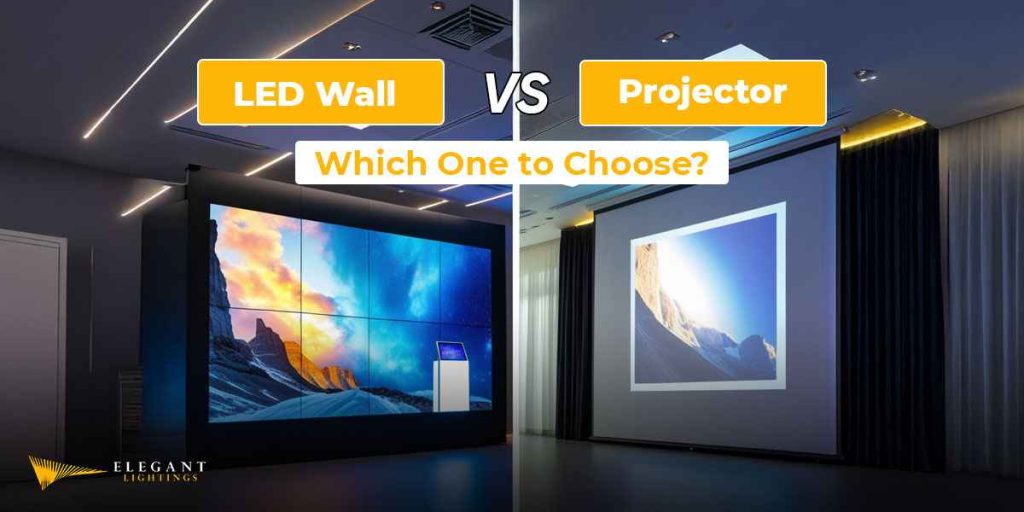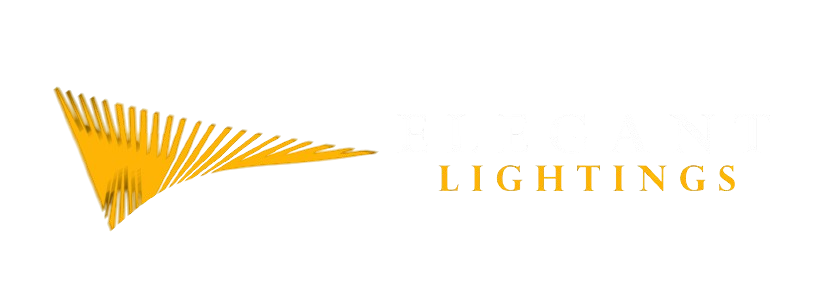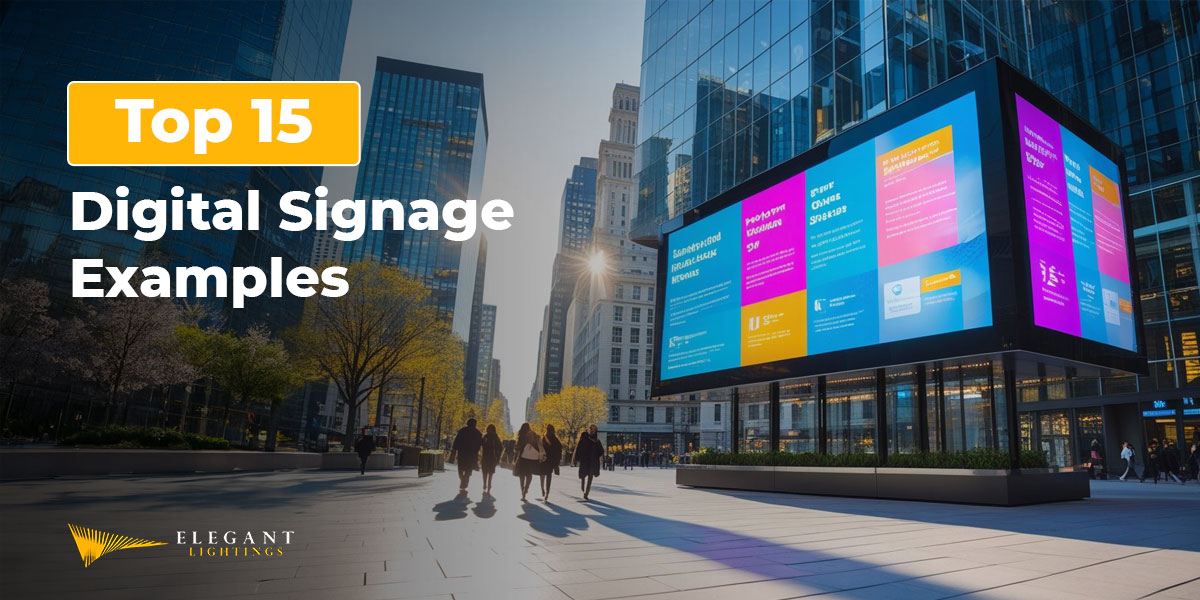LED walls or projectors: which one should you choose for your location or event?
What's on this page:
We’ve seen a lot of our clients struggle with this question, and we’ve successfully helped them pick a solution that aligns with their requirements.
Here’s the thing: the answer depends completely on your requirements!
If you’re looking for the perfect LED lighting solution for your corporate offices, art gallery, or classrooms, you might want the flexibility and high shelf life of LED projectors.
On the other hand, if you need a permanent fixture at one of the busiest avenues or malls in your neighborhood that works under all light conditions? An outdoor LED wall is the way to go!
But what makes LED walls and projectors suited to different applications? And which one offers the features you need?
Those are exactly the questions we’ll answer in this blog.
We’ll discuss the A-Z of LED walls vs projectors, and give you a detailed breakdown on which one to use under what conditions.
Let’s dive in!
LED Walls vs. Projectors: Table of Contents
- TL;DR: LED Walls vs. LED Projectors – Table of Differences
- What is an LED Wall?
- When to Use LED Walls?
- What is an LED Projector?
- When to Use LED Projectors?
- Final Thoughts: LED Walls or LED Projectors?
- LED Walls vs. LED Projectors: FAQs
TL;DR: LED Wall vs Projectors – Table of Differences
In a hurry? I’ve got you covered!In a hurry? I’ve got you covered!
Below you’ll find a quick summary of how to choose between LED walls and projectors, and a feature-wise comparison of both LED lighting solutions:
- Go for LED walls if you’re looking for a permanent lighting solution that works under all lighting conditions.
- Choose LED projectors if you’re working with controlled lighting conditions and need a cost-effective solution.
| Feature | LED Wall | LED Projector |
| Brightness | Excellent (1,000–5,000+ nits) | Moderate (400–3,000 lumens) |
| Viewing Conditions | Suited to all ambient conditions | Needs controlled lighting environments |
| Cost | High up-front investment (can also go for rentals) | Budget-friendly(makes more sense to buy outright) |
| Installation | Complex but modular | Simple and mobile |
| Maintenance | Periodic, but minimal | Minimal |
| Lifetime | 100,000 hours; 10 years | 20,000-30,000 hours; 2-3 years |
| Best For | Permanent, high-impact displays | Portable, flexible setups |
What is an LED Wall?
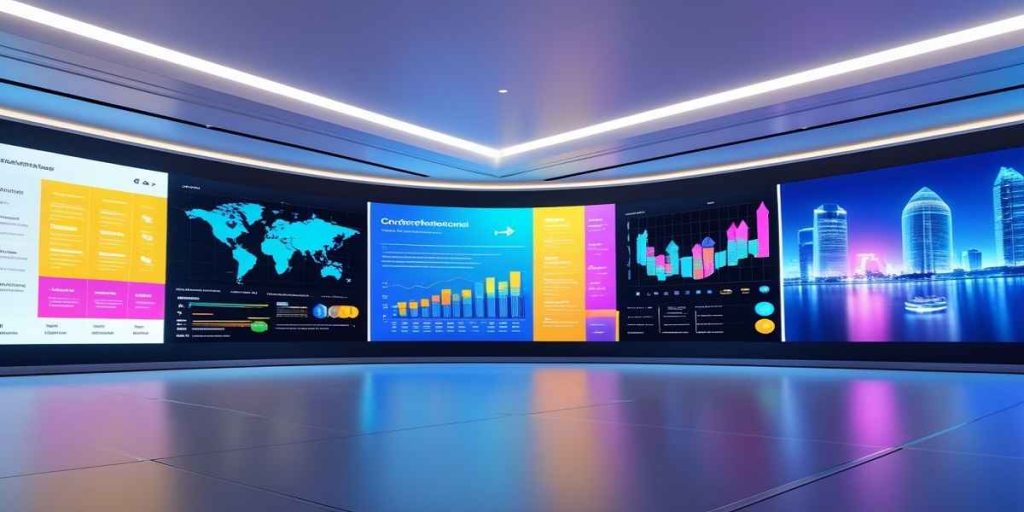
An LED wall is a panel made up of hundreds and thousands of RGB (red, green, & blue) LEDs, each less than the size of a sharp pencil point.
All of these tiny LEDs directly emit light as part of the panel, creating vibrant displays with a mix of colors and deep blacks.
If you’ve ever walked across Times Square and looked at the mesmerizing displays & ads, that’s an LED panel doing its job!
Let me quickly walk you through the features of an LED wall.
Features of LED Walls
There are seven main features of LED walls that you need to know about:
-
- Outdoor LED Walls have a pixel pitch of 3-5mm. This is essentially the difference between each LED in the panel. The larger pixel pitch of outdoor LEDs (compared to indoor LED walls) ensures a glare-free and clear viewing experience for passers-by and foot traffic.
-
- The brightness of LED walls ranges between 1,000 (for indoor LEDs) to 5,000+ (for outdoor LEDs) nits. So, whether you’re dealing with bright ambient conditions or dim ones, your message or ad will be vibrantly visible to your audience.
-
- Depending on the panel density, you can get an LED wall with resolutions of up to 8K for crystal-clear visuals.
-
- LED walls offer exceptionally wide viewing angles of up to 160 degrees. This makes them suitable for both wide (billboards or signboards) and narrow (concert) views.
-
- LED walls are designed for long-term usage. With periodic (but minimal) maintenance, your LED wall can last for up to 100,000 hours (10 years)!
Also Read: How You Can Benefit From Using Video Walls in 2025
Pros and Cons of LED Walls
Now that we’ve looked at the features of LED walls, let’s explore their pros and cons:
Pros
-
- Resistant to dust, snow, moisture, and heat – suited to any & every environment.
-
- Bezel-free displays: you won’t see any lines on your LED panels.
-
- LED walls are modular: you can add more LEDs to expand the size, combine multiple panels into a larger display, or even shift their location.
Cons
-
- LED walls are expensive, so you might have to make a hefty upfront investment (although you can also go for rentals for short-term solutions).
-
- While they are modular, they’re also difficult to move without professional and technical support.
When to Use LED Walls?
Based on their features, pros & cons, LED walls are most suited to the following use-cases:
-
- Corporate & Retail: If you need digital signage for lobbies, trade shows, or indoor retail promotions, LED walls could be your ideal solution!
-
- Entertainment: LED walls can help you light up concerts, festivals, and stage backdrops with immersive visuals.
-
- Public Spaces: The permanence and minimal maintenance of LED walls make them highly suited to airports, train stations, and outdoor messaging (billboards).
-
- Virtual Production: LED walls have become crucial to film and TV studios for creating real-time CGI backgrounds. For e.g., most of the scenes in The Mandalorian were shot using LED walls!
-
- Control Rooms & Security: If you need a screen for monitoring mission-critical areas with multiple-source feeds, LED walls offer excellent visual clarity without requiring extensive maintenance.
What is an LED Projector?
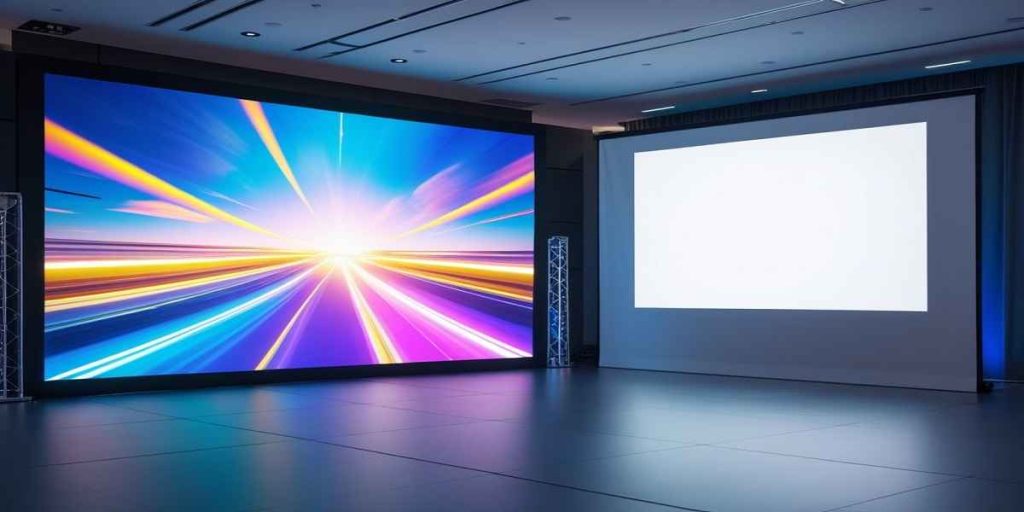
LED projectors use light-emitting diodes to project images onto a screen. So, they’re different from traditional projectors that use lamps and LED walls that themselves act as screens as well as projectors.
They also don’t need a color wheel and operate through tiny LEDs, each emitting a different color for clear and vibrant visuals.
Features of LED Projectors
Let me walk you through the most essential features of LED projects:
-
- The brightness of LED projectors is measured in Lumens – they offer up to 3,000+ Lumens of brightness, making them suitable for environments with controlled lighting conditions.
-
- They support up to 1080p and 4K UHD display qualities, with up to 8.3 million pixels for ultra-sharp images.
-
- LED projectors can last between 20,000 and 30,000 hours, which is equivalent to between 2 and 3 years.
-
- LED projectors don’t require a heating up or cooling down period: they can go from 0 to 100 at the touch of a button!
Pros and Cons of LED Projectors
Now that we’ve explored the main features of LED projectors, let’s explore the advantages of projectors along with their limitations:
Pros
-
- Lightweight and portable: you can easily carry them to different locations.
-
- Highly efficient as they convert minimal energy into maximum brightness and picture clarity.
-
- You can use your projector to display visuals on any screen, which means you don’t need to invest in a permanent panel or screen.
Cons
-
- Lower brightness levels compared to LED walls – you might struggle with visibility in high-brightness ambient conditions.
-
- LED projectors offer lower contrast compared to LED walls. For instance, black might appear grey with LED projectors!
When to Use LED Projectors?
LED projectors are flexible, require minimal investment, and can be transported easily. Thus, the advantages of projectors make them highly suited to the following use cases:
-
- Home Theater Setups: The high-quality 4K HD resolution of LED projectors makes them an ideal choice for sophisticated home theater setups.
-
- Gaming Competitions: Need a big-screen gaming with low input lag? LED projectors are your best bet at getting the job done under budget!
-
- Meetings, Lectures, Seminars: This is the perfect use case for LED projectors; they can light up any presentation, lecture, or seminar in a closed space with controlled lighting.
-
- Events & Travel: If you need a portable lighting machine for business trips, outdoor movie nights, or picnics, a portable LED projector is what you need!
-
- Art & Decor: LED projectors can also be used to project high-quality murals, interactive art, and seasonal decorations without requiring expensive investment and heavy installation.
Final Thoughts: LED Wall vs Projectors?
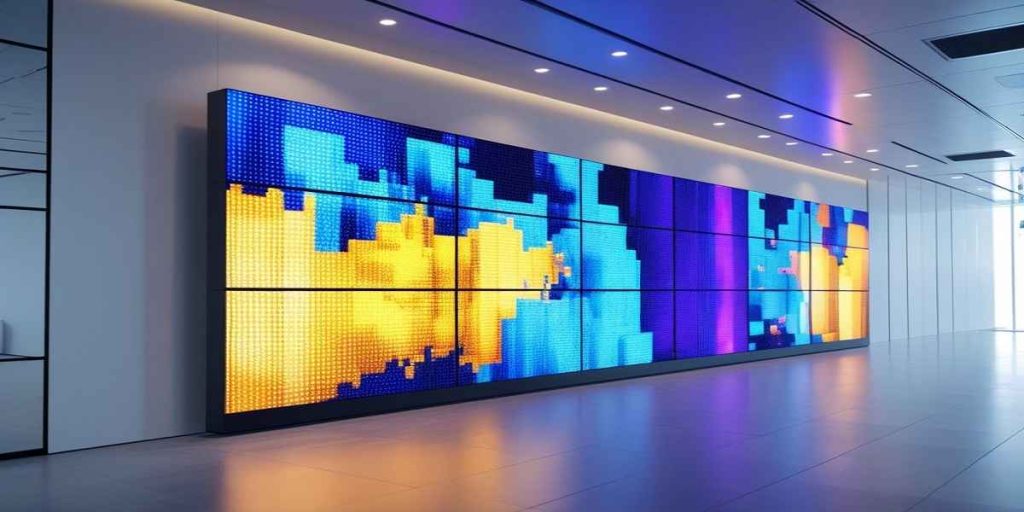
Through this blog, we’ve discussed the definitions, features, pros, and cons of LED walls and projectors.
As you can see, both have their own strengths and limitations, which make them uniquely suited to different use cases.
My suggestion:
-
- Invest in outdoor LED walls if you need to capture foot traffic in huge or wide spaces. They’ll work in all conditions without compromising the quality of visuals.
-
- Rent indoor LED panels for short events like trade shows, weddings, and concerts.
-
- Buy LED projectors for your corporate offices, classrooms, art galleries, or seminar halls.
And if you’re still not sure which one best fits your needs, reach out to us at Elegant Lightings!
We offer end-to-end LED lighting solutions from consultation & custom design to installation & maintenance. We also offer a wide range of indoor and outdoor LED walls and LED projectors.
Connect with us, and we’ll help you find the perfect solution to light up your event or location!
LED Walls vs. LED Projectors: FAQs
1. Which is Better for Bright Environments: LED wall vs Projectors?
In our experience, LED walls are far superior at getting the job done in bright environments because they emit their own light (their brightness ranges from 1,000 to 5,000+ nits). LED Projectors, on the other hand, rely on reflected light and struggle in well-lit spaces, making them better for controlled lighting conditions.
2. LED Wall vs. LED Projector: Which Is More Cost-Effective?
LED Projectors are cheaper upfront, making them ideal for temporary or budget setups. However, LED walls are better if you’re looking for a long-term solution due to their durability (100,000+ hours lifespan) and minimal maintenance. So, while LED walls cost more, they’ll pay you back over a period of 10 years!
3. Can I Rent Outdoor LED Walls for Events?
Absolutely! Many companies like Elegant Lightings offer outdoor LED wall rentals for concerts, festivals, and public viewings. They’re perfect for high-impact visuals in sunlight and can be customized in size and resolution.
4. Which is More Portable: LED Wall or Projectors?
Projectors are better for outright portability: they’re lightweight and easy to move. LED walls also offer flexibility: they are modular and can be moved. However, they’re both heavy and require professional assistance for assembly, installation, and maintenance. For temporary events, we suggest renting LED projectors or indoor LED walls.
5. LED wall vs. projector: Which Has Better Image Quality?
LED walls deliver sharper resolution (up to 8K), deeper blacks, and wider viewing angles of up to 160 degrees. They also offer sharper contrasts and come in different sizes (indoor vs outdoor panels), making them suitable for a wide range of ambient conditions. LED projectors, on the other hand, can display high-quality images but lose clarity in bright rooms and have narrower viewing angles.


